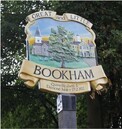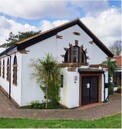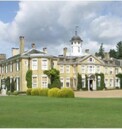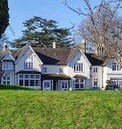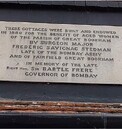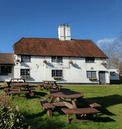Bookham's Heritage Trails and History
Spend a day exploring the beautiful villages of Great and Little Bookham and you’ll discover what makes them so... great!
Thank you to Mole Valley Together and Leatherhead Local History Society for providing the content for this page.
Discovering The Bookhams
Meandering footpaths link the villages to the historic oak woodlands of Bookham Commons. King Henry VIII is rumoured to have ridden here, whilst Victorian day trippers escaped London for the scenic sanctuary. World War II soldiers are even believed to have camped on the Commons in preparation for D-Day.
Royals, politicians, celebrities and socialites were amongst the village visitors of the past. However, the lavish splendour of Polesden Lacey’s infamous socialite parties were a direct contrast to one local resident’s attempt to turn Bookham dry!
The birthplace of a rock legend, the backdrop to a literary masterpiece... you’ll discover these and many other stories as you retrace the steps of medieval villagers, Tudor tenants and Lords and Ladies of the Manor.
Bassist' Birthplace
Legendary bass player Roger Walters, co-founder of influential rock band Pink Floyd, was born in Great Bookham on 6th September 1943. Five months later his father Eric (a former conscientious objector who had a change of heart and signed up to the Territorial Army after his son was born) was killed during the Battle of Anzio in Italy.
Chrystie's Quest
During the second half of the 19th century, Bookham resident Mary Chrystie made it her mission to turn the parish dry. A strong supporter of the Temperance Movement, she succeeded in closing at least five pubs across the two villages including The Saracen & Ring Inn, The Fox Ale House, The Halfway House, The Childs Hall pub and The Kings Arms. The hotels that Chrystie opened instead were all alcohol free.
Polesden’s Parties
From 1906-1942 super-rich socialite Dame Margaret Greville was the last private owner of Polesden Lacey, hosting lavish parties for guests that included King Edward VII, Winston Churchill, playwright Beverly Nichols and Queen Ena of Spain (Queen Victoria's youngest granddaughter).
During World War I half of the house was used as a convalescent home for wounded officers. Back to its celebratory best, the future King George VI and Queen Elizabeth (the Queen Mother) honeymooned at Polesden Lacey in 1923.
Mrs Greville died in 1942 and bequeathed much of her jewellery collection to Queen Elizabeth and the house, its contents and grounds (where she is buried) to the National Trust.
Uncommon Generosity
The three Commons which make up the area of Bookham Common, designated a Site of Special Scientific Interest for the varied and rare species of flora and fauna, were gifted to the National Trust to protect them from development.
After deeds to Great Bookham Common were included in the purchase of Eastwick Park, residents raised funds to buy the Common back and gifted it to the National Trust in 1923. Little Bookham Common and Banks Common were gifted to the Trust by their owners in 1924 and 1925 respectively.
Literary Links
Jane Austen drew inspiration from this part of Surrey for a number of novels, in particular ‘Emma’ (published 1815). She made regular visits to Great Bookham, staying with the Cooke family; her aunt, uncle and cousins. Rev Samuel Cooke, who was also her godfather, was the vicar of Great Bookham from 1769-1820. Another significant literary female writer with close links to Great Bookham was Frances (Fanny) Burney (1752 - 1840) who lived in Bookham from 1793-97.
Although today she is much less celebrated than Jane Austen, when published her novels (including ‘Evelina’ and ‘Camilla’) were hugely popular.
A century later CS Lewis, the creator of Narnia, was privately tutored by his father’s former headmaster in Great Bookham during 1914-17. Six months after leaving Bookham, Lewis fought in the Great War; the trenches in France a world away from the serenity of village life.
Heritage Walking Trails
Two easy to walk trails around the historic villages of Great and Little Bookham. Produced by Mole Valley Together
A history of The Bookhams
Provided by Ali Kelman of the Leatherhead Local History Society.
When we speak of a 'Manor' we are talking about a system that formed the administrative and economic unit of agricultural organisation in England to the end of the 18th Century. A typical manor would have contained a village with a church and agricultural land. The 'lord of the manor' usually had a large block of this land. This would have included, the Manor House and its grounds, the cottages and gardens of the tenants, the common fields, the farm buildings and any areas of waste land. It was very common for the 'lord of the manor' to sell off part of his estate which would become a 'Manor' within itself. This was known as a sub-manor and the owner held the same rights over it as if it were a manor.
Although an individual might become the 'lord of the manor' simply by purchasing an estate such as Eastwick it did not bequeath the owner with the title of 'Lord', the right to sit in the House of Lords or to become a 'peer'. Indeed certain obligations could go with the Manor such as helping maintain the church and repairing roads through the village.
In 1627 The Howard family resided in the Manor of Great Bookham, the Manor House of which was located on Lower Road, East side of St Nicolas Church, with entrances to Lower Road and Church Road. As the house was not sufficiently imposing the family moved to nearby Eastwick Park which was a sub-manor, and we assume that the house was already standing at the time. This was purchased by Sir Francis Howard in 1626 who merged it with the Manor of Great Bookham and it then became the family seat.
The Howard family held the estate until 1801 when it was sold by Richard Howard, Earl of Effingham, to James Laurell.
Date | Event | ||
|---|---|---|---|
1806 | James Laurell further enhanced the appearance of Eastwick Park house | ||
1809 | Sold to Mr. Louis Bazelgette and then passed | ||
1833 to 1882 | Mr. David Barclay MP for Sunderland | ||
1882 to 1912 | Mr. William Keswick MP for Epsom | ||
1912 to 1918 | Mr. Henry Keswick MP | ||
1918 to 1922 | Mr. Hipplyte Louis Wiehe du Coudray Souchon (retired Sugar Planter) | ||
1922 to 1924 | Mr. Percy Portway Harvey Property Developer and Estate Agent. (Land sold off in plots for house building) | ||
1924 to 1954 | Mr. H. Fussell. Southey Hall Preparatory School. (purchased house, outbuildings and kitchen garden) | ||
1955 to 1958 | House Empty 1958/59 | ||
1958 to 1959 | House demolished - Eastwick County Primary School built. |
